Silence (15) - Mai Văn Phấn. Explication par Dr. Ramesh Chandra Mukhopadhyaya. Traduction française Dominique de Miscault
Mai Văn Phấn
Explication par Dr. Ramesh Chandra Mukhopadhyaya
Traduction française Dominique de Miscault
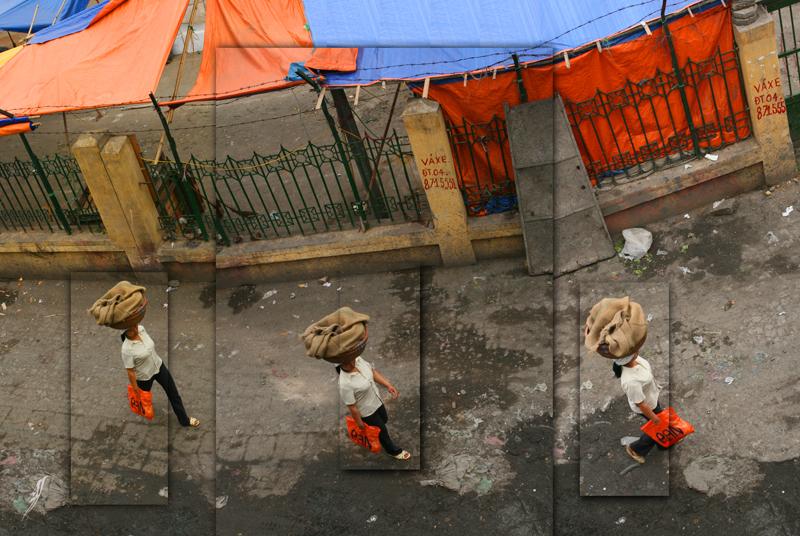
Long Bien ou le pont de tous les songes - Dominique de Miscault
Silence
15.
Un
oiseau noir pique
toit
noir
terre noire
lumière incolore
Tout est blanc comme le
lait.
Je brûle comme un tronc d'arbre
creusé par des insectes
l’oiseau est blessé
sol ébranlé
végétation empoisonnée
Je rassemble la lumière
amasse des larmes
pour panser les blessures
Tout est blanc comme le
lait.
Explication
Le poème est une pièce en noir et blanc. Le noir, mystère abyssal
de l'existence et tant qu'il s'agit d'un mystère, il est noir. Dès que le
mystère s’éclaircit, il devient blanc. L'ignorance révèle un monde en noir. Ce
qui semble noir à l'ignorance est blanc à la sagesse.
Le poème s'ouvre sur l’image d’un oiseau noir, un toit noir et un
terrain noir. Le noir comme absence de couleur.
L'absence de toute couleur signifie l'obscurité primordiale là où
il n'y a pas de trace de lumière. Le poète décrit-il l'état primordial avant la
création dans l'image ?
Un oiseau noir pique
toit noir
terre noire
lumière incolore
Nous voyons un toit, le sol avec un merle noir dans l'obscurité
translucide.
Le toit signifie le plus grand et le plus haut, à défaut de toutes
descriptions. Le toit pourrait aussi signifier la tête et l'intellect. C'est
noir parce qu'il trompe la compréhension. L'oiseau noir disparait dans le toit.
La dualité agit comme le point d'appui de la libération conditionnelle du
poème. L'oiseau disparait aussi sur un terrain noir. Le cloaque implique que
les fondations du toit ou du sol ne sont pas solides. Autrement dit, tout ce
qui est réputé être élevé et noble ou tout ce qui est considéré comme ignoble
et méchant, n'a aucun fondement ou essence. Il n'y a rien de solide dans l'existence.
Il n'y a pas de substance à l'existence. Ce tableau de mots rappelle les tankas
noirs de l'art tibétain monochrome. Il représente un espace multidimensionnel
infini avec un toit et un sol. Cela montre que ni le toit ni le sol, ou en
d'autres termes, les valeurs énoncées n'ont aucun fondement ou essence. S'il
n'y a pas de lumière, comment pouvons-nous décrire l'oiseau sur le toit ou par
terre. Bien que la lumière soit incolore. La lumière incolore ne nécessite ni
soleil ni lune ou étoiles. C'est au-delà de la conscience empirique. Le poète
est comme un évanouissement - un état dans lequel la conscience empirique est
suspendue et le poète peut maintenant décrire un plan de réalité derrière le
spectacle des choses sous la lumière claire du vide sans forme. Le sans forme
est incolore. La couleur implique et décrit la forme. La lumière incolore est
le sens des symboles du vide sans forme.
Le poète voit un merle dans une lumière incolore. L’oiseau représente
la sagesse, fidèle au ciel et au monde ordinaire.
dans le christianisme, un oiseau noir est de mauvais augure. Le
diable apparut à Saint Benoît sous la forme d'un merle pour le tenter.
La chronique anglaise commençe par une chanson à six pences qui se
termine par ces deux lignes
La femme de ménage était dans le
jardin étendant le linge
Quand
descendit un merle qui lui picota le nez
Ici, la femme de ménage représente ceux qui sont tentés par les
plaisirs charnels et le merle, le plaisir charnel lui-même.
L’oiseau noir fond sur un toit noir, dans un sol noir. En d'autres
termes, toutes les valeurs nobles ou ignominieuses sont diluées. L'oiseau noir
selon le bouddhisme tibétain est l'incarnation du Mahakala dont le nom signifie
littéralement LE NOIR. La couleur noire est associée au caché et à l’inconnu.
Il protège le mystère de l'existence de l'homme du commun. C'est le pouvoir et
le contrôle sur les sentiments et les émotions. Il s'abaisse disparait vers le
bas et pénètre encore plus profondément dans le sommeil primordial, dans le
cœur le plus secret de l'existence intérieure inconnue et inconnaissable de
l'homme ordinaire. Puis, une fois que nos traits négatifs tombent profondément
dans le cœur des choses, la lumière incolore du vide, la lumière blanche du
trait positif brille.
Le vide est comme annulé. Supposons que les traits négatifs sont à
gauche. Plus tard, les traits positifs seront à droite. Une fois que les traits
négatifs se cachent au cœur des choses, les traits positifs ou la couleur blanche
apparaissent.
Tout est blanc comme le lait.
Mais le blanc ici, ne parle pas de paix ni de beaucoup de clarté. Le poète sent
qu'il brûle :
Je brûle comme un tronc d'arbre
creusé par
des insectes
l’oiseau
est blessé
sol ébranlé
végétation
empoisonnée
Au contraire du noir, la couleur blanche illumine et pose un autre
regard où le poète peut se trouver comme un arbre creusé par la colère, la
jalousie et autres myriades d'insectes. L'oiseau noir que nous avons rencontré
plus tôt peut-être s'est perché sur l'arbre de l'être du poète. Dans le blanc
de la lumière, nous le trouvons blessé. Il n'y a pas non plus là de stabilité
dans ce monde trempé de blanc, de pureté et de pudeur. Convulsions terrestres.
La végétation est empoisonnée. La pureté est consciente du fait qu'elle n'est ni
impure ni empoisonnée. Le poison de cette conscience pollue le soi-disant pur.
Si vous pensez que vous n'êtes pas malhonnête, seule la malhonnêteté te
prendra. La vérité n'est ni blanche ni noire, ni noire ni blanche, ni blanche
ni noire.
Dans ces circonstances, le poète rassemble la lumière de son être
abominable et rassemble les larmes du monde souffrant. Quand on brûle de
douleur ou tout ce qu'il peut rassembler, feu et lumière sont de la même
essence. C'est ainsi que l'on peut s'enrichir de la souffrance. Le samsara ou
la vie mondaine est une vallée de larmes. Le poète participe au deuil auquel la
vie du monde n’échappe pas. La lumière comme les larmes traversent plaies et
souffrances. Le poète est guéri. En lui, tout blanchit comme du lait.
Ainsi, le blanc revêt deux fonctions dans ce poème. Quand il apparait
pour la première fois, il révèle le vide et les gémissements de l'existence.
Ils sont ce qu'ils sont en raison de l'existence du moi. L'arbre creux en feu
pourrait signifier l'ego mourant du poète. Le poète a jeté son ego aux flammes en
sacrifice. Quand le poète se débarrasse de son ego, la lumière des flammes et
des larmes s'unissent. L'illumination est la sagesse et la compassion sans
bornes soudées ensemble. La seconde fonction de la lumière a lieu quand elle
guérit les souffrances de l'homme. Ce n'est plus la lumière trouvée sur la mer
ou la terre, c'est la lumière du vide. Le vide n'est pas l'absence de tout, c'est
plutôt le trésor inconnu où tout ce qui est banal et quel que soit l’au-delà du
sensible, tout pourrait être considéré comme le même. Quand on brûle son ego
une fois pour toutes, ce qui semblait obscurité, ignorance devient lumière de
la sagesse.
Non. Les souffrances ne se terminent pas une fois pour toutes,
mais avec le poète sans ego, l'existence est illimitée, souffrant d’une lumière
infinie d'amour et de compassion. Bouddha, est un présent éternel. Le poème se
termine au présent ... Tout est blanc comme du lait. Pourquoi le blanc est-il comparé
au lait ? Parce que le vide soutient le monde tout comme le bébé nouveau-né est
soutenu par le lait. Le vide est le zéro dans lequel les graines de tous les
chiffres négatifs et tous les chiffres positifs se cachent. Il blanchit comme
du lait dans l'œil intérieur du poète.
Dominique de Miscault:
Artiste Plasticienne. De plages en pages qui se tournent. C’était hier, de 1967 à 1980, mais aussi avant hier, dominiquedemiscault.com. puis de 1981 à 1992. Et encore de 1992 à 2012 bien au delà des frontières. Aujourd’hui, la plage est blanche sous le bleu du soleil.
(http://www.dominiquedemiscault.fr)
Silence (15) by Mai Văn Phấn
Explicated by Dr. Ramesh Chandra Mukhopadhyaya
Translated into Vietnamese by Phạm Minh Đăng
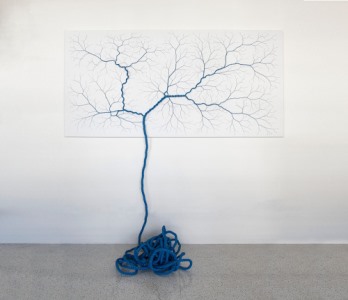
Tác phẩm của Janiana Mello and Daniel Landini
Silence
15.
A black bird sinks in
A black roof
A black ground
And colorless light
All is whitening like milk.
I am burning like a tree trunk
Hollowed out by insects
The bird is wounded
The ground is convulsing
All vegetation is poisoned
I gather light
And collect tears
To stream through our wounds
All is whitening like milk.
(Translated from Vietnamese by Nhat-Lang Le & Susan Blanshard)
Explication
The poem is a play between black and white. Black stands for the abysmal mystery of the existence. As long as it is a mystery it is black. As soon as the mystery is unravelled it is white. Ignorance reveals the world as black. What seems black to ignorance is white to wisdom.
The poem opens with a black bird, black roof and black ground. Black is the absence of any colour whatever.
The absence of any colour whatever signifies primordial darkness where there is no trace of light. May be the poet describes the primordial state prior to the creation in the image-
A black bird sinks in
A black roof
A black ground
And colorless light
We see a roof and the ground where a blackbird sinks in translucent darkness.
A roof means the greatest highest and utmost that baffles any description. Roof might mean the head and the intellect as well. It is black because it baffles understanding. The black bird sinks in the roof. Duality acts as the fulcrum of the parole of the poem. The bird also sinks on a black ground. Sinking implies that the foundations of either the roof or the ground is not solid. That is, whatever is deemed to be lofty and noble or whatever is deemed as ignoble and mean, have no foundation or essence. There is nothing solid in the existence. There is no substance in the existence. A unique word painting reminiscent of black thangkas of Tibetan art in monochrome. It depicts a multidimensional infinite space with roof and ground. That shows that neither the roof nor the ground, or in other words the so called values donot have any foundation or essence. If there is no light how can we descry the bird the roof and the ground. Well there is colourless light. Colourless light needs no Sun or Moon or stars as its source. It is beyond the ken of empiric consciousness. The poet is as it were in a swoon - a state in which empiric consciousness is suspended and the poet can now descry a plane of reality behind the show of things in the clear light of the formless void. Formless is colourless. Colour implies and denotes form. Colourless light is the sensesymbol of the formless void.
The poet sees in his vision a blackbird in the colourless light. A bird is the type of the wise, true to the kindred points of heaven and the mundane world.
As per Christianity a black bird is ill omen. Devil came to Saint Benedict in the shape of a blackbird to tempt him.
The English nursery rhyme beginning with Sing a song of six pence ends with the two lines
The maid was in the garden hanging out the clothes
When down came a blackbird and pecked off her nose
Here the maid stands for those who are tempted by carnal pleasures and the blackbird is carnal pleasure itself.
The blackbird sinks in a black roof and in a black ground. In other words all the values be it noble or ignominious seem to sink. The black bird according to Tibetan Buddhism is the incarnation of Mahakala or whose name means literally Black One. The colour black is associated with the hidden and unknown. It protects the mystery of existence from the common man’s ken. It is power and control over feelings and emotions. And it sinks down sinks down and sinks deeper into the primordial sleep, into the most secret heart of the inner existence which is unknown and unknowable to the ordinary run of men. And once our negative traits sink deep into the heart of things-the colourless light of void-the white light of positive trait shines.
The void is like zero. Assume that the negative traits are in its left. Then the positive traits are in the right. Once the negative traits hide themselves in the heart of things the positive traits or the white colour begins to generate.
And so at once all is whitening like milk
But the white here does not speak of peace and plenty and clarity. The poet feels that he burns
I am burning like a tree trunk
Hollowed out by insects
The bird is wounded
The ground is convulsing
All vegetation is poisoned
As the opposite of black, white colour illuminates and lays bare another plane where the poet can locate himself as a tree hollowed by anger jealousy lust and other myriads of insects. The black bird whom we met earlier may have perched on the tree of the poet’s being. In the white of the light we find it wounded. There is also no substance and stability in the world drenched in white or purity and piousness. The land convulses. The vegetation is poisoned. Purity is aware of the fact that it is not impure or poisoned. The poison of this awareness pollutes the so called pure. If you think that you are not dishonest dishonesty alone will hang heavy upon you. The truth is neither white nor black, neither not black nor not white, neither not not white nor not not black.
In this circumstances, the poet gathers light from his aburning being and gathers tears from the suffering world. When one is burning in grief or whatever he can gather the fire and light from the same. That is how one can enrich oneself with suffering. The samsara or the worldly life is a vale of tears. The poet participates in the mourning to which the worldly life is wont. And the light and tears stream through thepoets wounds. And the poet is healed. With him all is whitening like milk.
Thus the appearance of white has two functions in the poem. When it first showed up it revealed the hollowness and groans of existence. They are what they are because of the existence of the ego. The hollow tree aflame might stand for the dying ego of the poet. The poet has flung his ego into flames as sacrifice. When the poet gets rid of ego, the light of the flames and the tears unite. Enlightenment is wisdom and boundless compassion welded together. And the second function of the light takes place. It heals up the sufferings of man. It is no longer the light that one finds in the sea or land. It is the light of the Void. The void is not the absence of everything. Rather it is the untold treasure where whatever mundane and whatever supramundane could be found as the same. When one burns ones ego once for all what seemed the darkness of ignorance becomes the light of wisdom.
No. Sufferings do not end once for all. Rather with the poet sans ego the existence is boundless suffering drinking in infinite light of love and compassion. With a Buddha this is eternal present. Hence the poem ends in the present tense---All is whitening like milk. Why does the white likens the milk? Because the void sustains the world just as the new born baby is sustained by milk The void is the zero in which the seeds of all the negative digits and all the positive digits lurk. It whitens like milk before the inward eye of the seer poet.
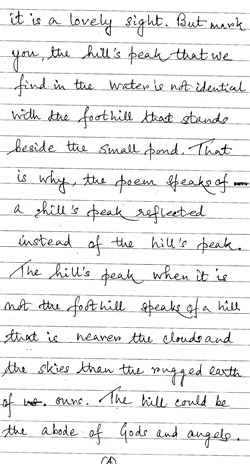
Thủ bút của Ts. Ramesh Chandra Mukhopadhyaya
Tĩnh lặng (15) của Mai Văn Phấn
Ramesh Chandra Mukhopadhyaya chú giải
Phạm Minh Đăng dịch sang tiếng Việt
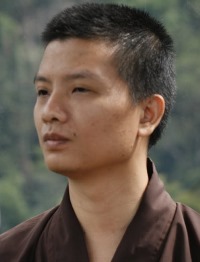
Dịch giả Phạm Minh Đăng
Tĩnh lặng
15.
Chìm vào cánh chim đen
Mái nhà
Mặt đất đen
Cùng ánh sáng không màu
Tất cả đang trắng ra như sữa
Tôi nóng một thân cây sâu đục
Cánh chim bị thương
Lòng đất quặn thắt
Vùng cây cỏ nhiễm độc
Gom ánh sáng
Dồn nước mắt
Chảy qua những vết thương
Tất cả đang trắng ra như sữa.
Chú giải
Bài thơ như một vở kịch giữa đen và trắng. Đen là những bí ẩn thăm thẳm của tồn tại. Khi vẫn là điều bí ẩn, nó có màu đen [bí ẩn thì đen]. Ngay khi vén màn bí ẩn, nó trắng. Vô minh lộ thế giới tối đen. Với sự vô minh - một thứ đen lại có màu trắng với hiền minh.
Bài thơ mở ra hình ảnh con chim đen, mái nhà đen và đất đen. Đen là sự vắng mặt của mọi màu sắc khác. Sự vắng mặt của mọi màu sắc biểu thị bóng tối nguyên khởi nơi không có chút ánh sáng nào. Có thể nhà thơ mô tả trạng thái sơ khởi tiền sáng tạo [tức trước khi mọi sự được sinh ra trên đời] này trong hình ảnh
Chìm vào cánh chim đen
Mái nhà
Mặt đất đen
Cùng ánh sáng không màu
Chúng ta thấy mái nhà và mặt đất nơi con chim đen chìm vào trong bóng tối trong suốt.
Một mái nhà mang nghĩa nơi cao rộng nhất từ chối mọi mô tả. Mái nhà có thể còn mang nghĩa cái đầu và sự thông thái. Mái nhà đen vì nó chống lại các sự hiểu. Con chim đen chìm trong mái nhà. Cặp đôi có vai trò như điểm tựa cho độ mở của bài thơ. Con chim cũng chìm vào đất đen. [Sự] chìm này biểu thị nền móng của cả mái nhà và mặt đất đều không chắc chắn. Nghĩa là, mọi điều dù như thể cao cả và đáng quý hay bình dị, tầm thường, đều không có nền tảng hay căn tính. Chẳng có gì vững chắc trong sự tồn tại. Cũng không có vật chất trong sự tồn tại. Một bức tranh ngôn từ độc đáo gợi nhắc đến các tranh tôn giáo đen của nghệ thuật đơn sắc Tây Tạng. Bức tranh vẽ một không gian vô hạn đa chiều với mái nhà và mặt đất. Không gian không phác ra mái nhà hay mặt đất, hoặc nói cách khác, cái gọi là các giá trị không có nền tảng hay thiết yếu tính. Nếu không có ánh sáng, làm sao ta có thể mô tả con chim, mái nhà và mặt đất. À, ở đó có ánh sáng không màu. Ánh sáng không màu không cần tới Mặt trời, Mặt trăng hay các vì sao làm nguồn sáng. Nó vượt qua các tri thức thường nghiệm. Nhà thơ như thể đang trong trạng thái bất tỉnh – nơi tri thức thường nghiệm ngừng lại và nhà thơ đang mô tả các lát cắt hiện thực đằng sau những trình hiện của sự vật trong ánh sáng trong lành của khoảng trống vô định thể. Vô định thể là không màu. Màu sắc làm rõ và tạo rõ hình khối. Ánh sáng không màu là biểu tượng nghĩa của một khoảng trống vô định thể.
Nhà thơ thu vào nhãn quan của mình hình ảnh con chim đen trong ánh sáng không màu. Con chim là một dạng của sự thông thái, sự thật với điểm giao cắt giữa thiên đường và trần thế.
Theo Kito giáo, con chim đen là điềm xấu. Quỷ dữ đến với Thánh Benedict trong hình dạng một con chim đen để cám dỗ ông.
Bài vè của Anh bắt đầu từ bài “Sing a song of six pence” được kết thúc với hai dòng
Người hầu trong vườn đang bận phơi phang
Chim đen bay xuống và mổ mũi nàng
Ở đây, người hầu biểu thị kẻ bị cám dỗ bởi những niềm vui trần thế và bản thân con chim đen cũng là niềm vui thế tục.
Con chim đen chìm trong mái nhà đen và mặt đất đen. Theo cách nói khác, những giá trị cao cả hay thấp hèn dường như đều chìm xuống. Con chim đen trong Phật giáo Tây Tạng là hiện thân của thần Mahakala, còn có tên gọi nữa là Ngài Đen. Màu đen gắn liền với sự ẩn giấu và cái chưa biết. Nó bảo vệ bí ẩn của tồn tại khỏi sự hiểu của người đời. Nó là sức mạnh và kiểm soát được cảm giác và cảm xúc. Và nó chìm xuống chìm xuống chìm xuống sâu hơn nữa vào giấc ngủ khôi nguyên, vào trái tim bí mật nhất của nội tại nơi không người thường nào biết và hiểu. Và khi các tính cách tiêu cực của ta chìm sâu vào tim sự vật – ánh sáng không màu của khoảng trống – ánh sáng trắng của các tính cách tích cực được tỏa rạng.
Khoảng trống giống như số không. Giả thiết rằng các tính cách tiêu cực ở phía bên trái. Khi đó các tính cách tích cực ở bên phải. Khi các tính cách tiêu cực ẩn mình trong tâm của sự vật, các tính cách tích cực hay màu trắng bắt đầu hoạt tác.
Và đến một thời điểm tất cả đang trắng ra như sữa.
Nhưng màu trắng ở đây không biểu thị cho nỗi yên bình, sự tràn đầy hay sáng rõ. Nhà thơ thấy mình cháy –
Tôi nóng một thân cây sâu đục
Cánh chim bị thương
Lòng đất quặn thắt
Vùng cây cỏ nhiễm độc
Phía đối diện màu đen, màu trắng tỏa chiếu và phơi bày một chiều kích khác, nơi nhà thơ có thể định vị mình như một cái cây bị đục rỗng bởi các ham muốn riêng tư và vô số loài côn trùng khác. Con chim đen chúng ta gặp trước đó phải chăng đã đậu trên cái cây hữu thể của nhà thơ. Trong màu trắng của ánh sáng chúng ta thấy con chim thương tổn. Không có vật chất và sự bền vững trên thế giới đắm chìm trong màu trắng hay sự thanh sạch và tôn kính. Đất đai ô nhiễm. Cây cỏ bị đầu độc. Sự tinh khiết nhận thức được sự thực rằng, nó không là sự pha nhiễm hoặc bị đầu độc. Chất độc của nhận thức này làm ô nhiễm cái gọi là sự thuần lành. Nếu ta nghĩ ta không trung thực, bản thân sự không trung thực sẽ đè nặng lên ta. Sự thực không có trắng hay đen, cũng không phải không trắng hay không đen, cũng không phải không - không trắng hoặc không - không đen.
Trong trạng huống này, nhà thơ thu gom ánh sáng từ hữu thể cháy của mình và gạn lại những giọt nước mắt từ thế giới đoạ đày này. Khi một người cháy trong đau thương hay bất cứ cảm xúc gì, họ có thể gom lửa và ánh sáng cũng từ thế giới đó. Đó là cách ta tự làm giàu bản thân trong chịu đựng. Trần gian luân hồi như một thung sâu nước mắt. Nhà thơ dự phần vào cuộc tang thương mà thế gian này đã quen. Và ánh sáng và dòng nước mắt chảy qua những vết thương của nhà thơ. Và nhà thơ được chữa lành. Với ông, tất cả đang trắng ra như sữa.
Không. Những đoạ đày không một lần là xong hết. Mà với nhà thơ, sự vô ngã, hiện tồn là đày đoạ vô biên đang đắm mình trong ánh sáng vô hạn của tình yêu và thấu cảm. Với một vị Phật, điều này là hiện tại vĩnh hằng. Vì vậy bài thơ kết ở thì hiện tại – tất cả đang trắng ra như sữa. Tại sao màu trắng lại giống với sữa? Do khoảng trống nâng đỡ thế giới như sữa nuôi dưỡng một trẻ sơ sinh. Khoảng trống là cái Không nơi hạt mầm của tất cả phần tử tích cực và phần tử tiêu cực ẩn mình. Nó trắng ra như sữa dưới con mắt hướng nội của nhà thơ tiên tri.
Tĩnh lặng - Silence (1)
Tĩnh lặng - Silence (2)
Tĩnh lặng - Silence (3)
Tĩnh lặng - Silence (4)
Tĩnh lặng - Silence (5)
Tĩnh lặng - Silence (6)
Tĩnh lặng - Silence (7)
Tĩnh lặng - Silence (8)
Tĩnh lặng - Silence (9)
Tĩnh lặng - Silence (10)
Tĩnh lặng - Silence (11)
Tĩnh lặng - Silence (12)
Tĩnh lặng - Silence (13)
Tĩnh lặng - Silence (14)
Biography of Dr. Ramesh Chandra Mukhopadhyaya
Address: 6/ 1 Amrita Lal Nath lane P.0. Belur Math Dist Howrah West Bengal India Pin code711202. Date of Birth 11 02 1947. Education M.A [ triple] M Phil Ph D Sutrapitaka tirtha plus degree in homeopathy. He remains a retired teacher of B.B. College, Asansol, India. He has published books in different academic fields including religion, sociology, literature, economics, politics and so on. Most of his books have been written in vernacular i.e. Bengali. Was awarded gold medal by the University of Calcutta for studies in modern Bengali drama.
Tiểu sử Tiến sĩ Ramesh Chandra Mukhopadhyaya
Địa chỉ: 6/ 1 đường Amrita Lal Nath hòm thư Belur Math Dist Howrah Tây Bengal Ấn Độ mã số 711202. Ngày sinh: 11 02 1947. Thạc sĩ văn chương, thạc sĩ triết học, tiến sĩ triết học [bộ ba] cùng với Bằng y học về phép chữa vi lượng đồng cân. Ông còn là một giảng viên đã nghỉ hưu của Trường đại học B.B, Asansol, Ấn Độ. Ông đã có những cuốn sách được xuất bản về nhiều lĩnh vực học thuật bao gồm tôn giáo, xã hội học, văn học, kinh tế, chính trị v.v. Hầu hết sách của ông đã được viết bằng tiếng bản địa là tiếng Bengal. Ông đã được tặng thưởng huy chương vàng của Trường đại học Calcutta về các nghiên cứu nghệ thuật sân khấu Bengal hiện đại.
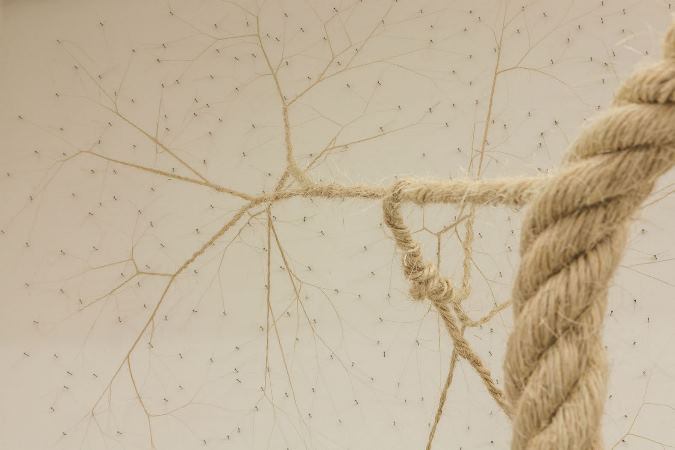
Tác phẩm "Những sợi dây thừng" của hai họa sỹ Janiana Mello và Daniel Landini, Brazil